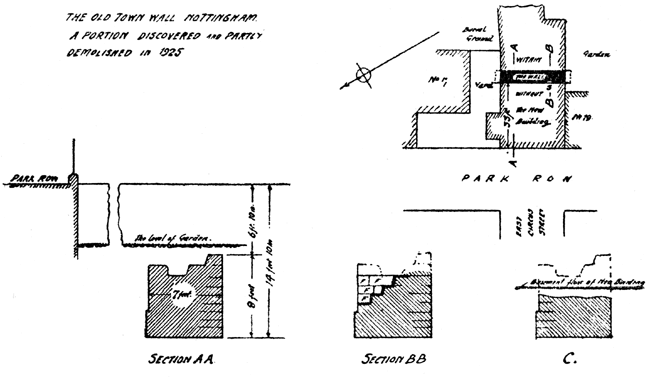< Previous
Old Town Wall, Nottingham.
By Ed. H. Heazell.
A familiar feature has disappeared from Park Row. familiar feature has disappeared from Park Row.
This was a garden between Nos. 17 and 19, sunk about 6ft. below the pavement and open to view through the iron palisade above the retaining wall.
The Nottingham (District) Cripples' Guild acquired the site in 1924 for the building of a Clinic, and in April, 1925, when the ground was being excavated for the foundations, there was exposed a length of the old town wall. It was 33ft. back from Park Row and was parallel with it.
The portion of the wall in relation both to Park Row and to the old and new buildings is shewn on the Key plan. The cross Section A.A. shows its thickness as 7ft. and that the top course was found 6ft. 10in. below the present level of Park Row. The length of the wall exposed was ten yards and it was observed that it continued at both ends under the adjoining yard and garden respectively. It is possible that the level of the old garden was also the level of Park Row hereabouts before it was widened and made in 1866.
The wall was built of roughly squared sandstone in courses varying from 9in. thick set in mortar with thin joints. There were three courses of footings projecting 2in. on the outside face of the wall only, and above this both faces were perfectly aligned and upright. The bottom course of footings was 14ft. 10in. below the pavement of Park Row measured in the middle of the 30ft. frontage of the new building and the top of the wall, as found, was irregular and indicated that an unknown number of courses had been removed. The average height of what remained was 6ft. 6in.
The section B.B. shows set-offs or steps about 2ft. long in the place indicated at S. on the plan. These set-offs may be due to decay before the ditch was filled in but for the fact that the stones marked F. had a fair return face as if they had been the jambs of an opening. The fair return face (or jamb) was at the N.E. side of such probable opening and the steps broke away into irregularity at their other end.

The section C. shows that, had the wall, as found, been left intact, it would have made a barrier right across the basement of the new building as much as 3ft. high in some places above the floor.
The stone was presumably a local sandstone and when first exposed was so soft that a groove could be made in it with the finger nail, and the mortar joints were quite soft.
A piece of the wall about 5ft. long was removed and rebuilt in the garden of Mr. Holland Walker, 15, Park Valley, Nottingham,
< Previous
